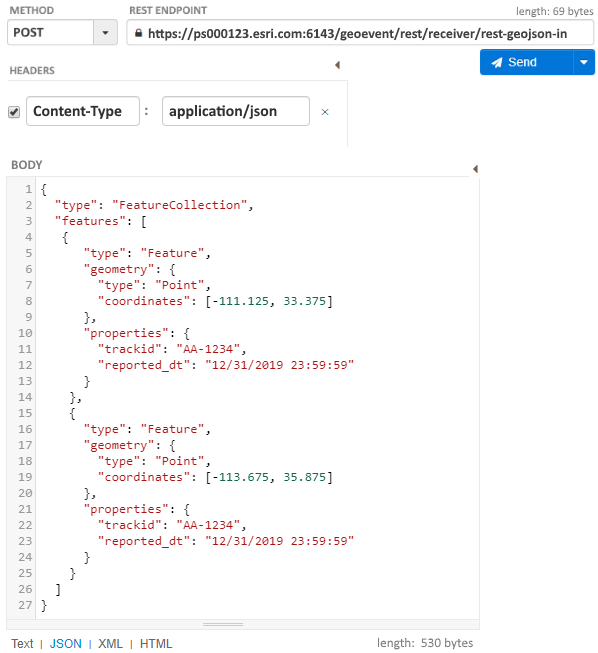The Receive GeoJSON on a REST Endpoint input connector can be used to receive and adapt event data, formatted as GeoJSON, on a REST endpoint hosted by ArcGIS GeoEvent Server. Given a standard GeoEvent Server configuration, data providers should expect to send data through HTTP/POST to an endpoint formatted as https://<machine_name>.<domain>:6143/geoevent/rest/receiver/name in which name is the name of the configured input connector.
Clients who want to send multiple data records should organize them as a FeatureCollection, as illustrated below. The GeoJSON inbound adapter will handle each feature record in the FeatureCollection as a separate event data record. The GeoJSON illustrated below will be adapted to produce two event data records for a GeoEvent Service to process.
For more information on examples of GeoJSON data record formatting, see the GeoJSON specification.

Usage notes
Keep the following in mind when using the Receive GeoJSON on a REST Endpoint input connector:
- Use this input connector to receive data, formatted as GeoJSON, sent using an HTTP/POST to a GeoEvent Server hosted REST endpoint.
- This input connector pairs the GeoJSON inbound adapter with the HTTP inbound transport.
- A typical GeoJSON FeatureCollection is illustrated above. The collection in this example has two GeoJSON feature records.
- The adapter will handle both single GeoJSON feature records and GeoJSON FeatureCollection records.
- Like feature JSON, GeoJSON is a subtype of generic JSON. DifferentGeoEvent Server adapters are used to process these specific formats.
- For more information and examples of GeoJSON data record formatting, see the GeoJSON specification.
- Configuring and saving a new Receive GeoJSON on a REST Endpoint input connector creates a GeoEvent Server hosted REST endpoint.
- You can recover the fully qualified path to the GeoEvent Server hosted REST endpoint by editing the input after it has been saved.
- GeoEvent Server can be configured to use a different base URL for its REST receiver and connect through a port other than 6143.
- A data provider must include, in the header of their HTTP/POST, the MIME type associated with the data being sent.
- The input you configure should specify which MIME types the transport will accept.
- This input connector expects the MIME type application/json, which is a default MIME type for the exchange of JSON between a client and server.
- Valid GeoJSON feature records include both a geometry and properties. This connector cannot be used to construct a geometry from coordinates received as property values. All GeoJSON feature records use the World Geodetic System 1984 (WGS84) datum with coordinate values expressed as longitude and latitude units in decimal degrees. Do not specify a default spatial reference when using this connector.
Parameters
The following are the parameters for the Receive GeoJSON on a REST Endpoint input connector:
| Parameter | Description |
|---|---|
Name | A descriptive name for the input connector used for reference in GeoEvent Manager. |
Create GeoEvent Definition | Specifies whether a new or existing GeoEvent Definition should be used for the inbound event data. A GeoEvent Definition is required for GeoEvent Server to understand the inbound event data attribute fields and data types.
|
GeoEvent Definition Name (New) (Conditional) | The name assigned to a new GeoEvent Definition. If a GeoEvent Definition with the specified name already exists, the existing GeoEvent Definition will be used. The first data record received will be used to determine the expected schema of subsequent data records, a new GeoEvent Definition will be created based on that first data record's schema. The parameter is shown when Create GeoEvent Definition is set to Yes and is hidden when set to No. |
GeoEvent Definition Name (Existing) (Conditional) | The name of an existing GeoEvent Definition to use when adapting received data to create event data for processing by a GeoEvent Service. The parameter is shown when Create GeoEvent Definition is set to No and is hidden when set to Yes. |
Default Spatial Reference | The well-known ID (WKID) or well-known text (WKT) of a spatial reference system in which the geometry's coordinates are expressed. This parameter has no default value. |
Acceptable MIME Types (Server Mode) | Specifies the MIME types the input connector will accept. Use commas to separate values, for example: text/plain,application/xml,text/xml. MIME types typically consist of a type/subtype structure and are used when a server must specify the internet media types of data it accepts from clients. The default is application/json, which is the official MIME type for the exchange of JSON between a client and server. For more information on official MIME types, see Internet Assigned Numbers Authority (IANA). For more information on the MIME types not used by ArcGIS Server, see MIME types not used by ArcGIS Server. |
Expected Date Format | The pattern used to match expected string representations of date/time values and convert them to Java Date values. The pattern's format follows the Java SimpleDateFormat class convention. While GeoEvent Server prefers date/time values to be expressed in the ISO 8601 standard, several string representations of date/time values commonly recognized as date values can be converted to Java Date values without specifying an Expected Date Format pattern. These include the following:
If the date/time values received are expressed using a convention other than one of the five shown above, you will have to specify an expected date format pattern so GeoEvent Server knows how the date/time values should be adapted. |
Parameter Name for the Raw Data | The name of the query parameter whose value provides the raw data for inbound HTTP/GET requests. The query parameter’s value should be a single string formatted as a GeoJSON feature or GeoJSON FeatureCollection. |